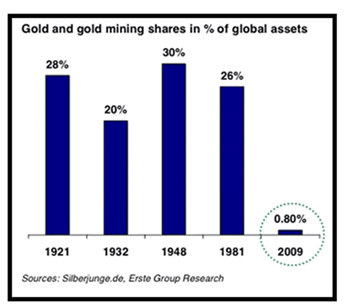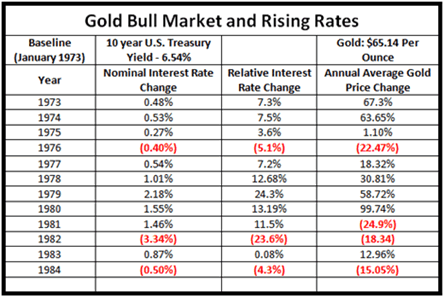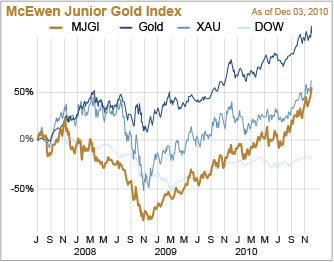Nine Responses to the “Gold Is A Bubble” Crowd
Commodities / Gold and Silver 2011 Jan 24, 2011 - 04:52 AM GMTBy: Q1_Publishing

 The “Gold is a Bubble” crowd has been reawakened.
The “Gold is a Bubble” crowd has been reawakened.
CNN warned earlier this week: Gold is a bubble, resist its charms.
Gold’s six percent fall in the last six weeks and the Amex Gold Bugs Index (HUI) nearly 20% decline have signaled the gold correction is here.
The correction has emboldened the anti-gold crowd more than they have been since the 2008 credit crunch.
The correction is has been a tough one so far. But it hasn’t shown itself to be anything more than just a correction. And if history is any example, it will last about two more months and gold will be returning to new highs by the end of 2011.
Despite the needed correction, gold’s future is as bright as ever. Contrary to rising opinion, gold is not in a bubble…yet. Here are nine reasons why.
1. Still Waiting for the Blow-Off Top
The top of every bubble has been marked by a massive, parabolic surge in prices.
The NASDAQ rose from 1500 to more than 5,000 between October 1998 and March 200. That was an 18 month increase of 233%.
The last gold bubble ended in three years of significant and accelerating increases in annual average gold prices. Gold went up 30.81% in 1978. It rose 58.72% in 1979. And “the top” was marked by a parabolic 99.74% increase in 1978.
Gold prices have risen at an annual average rate of 18% in this current bull market. In the last three years gold has risen at a 16% annual rate.
Even best-case scenario intended to skew the numbers to the most extreme fails to match previous bubble tops. Gold rose at annual average rate of 29.8% from its 2008 lows to its 2010 all-time high.
These increases are indicative of a bull market, but pale in comparison to past bubbles.
2. Gold Hasn’t Gone Mainstream…Yet
Bubbles suck a lot of investors in at the top. Panic buyers, fearful of missing out on an opportunity to get rich quick, rush in at the end in droves.
For example, in 1970, investors had $48 billion in stock mutual funds. By the top of the stock bubble in 2000, investors had more than $7 trillion in stock funds. In 2000 investors plowed $309 billion of new capital into stock funds. That’s five times more than all of the money invested in funds in 1970.
Stock fever was well-dispersed too at the top too. The New York Stock Exchange found 7.5 million Americans own stock in 1954. The number of stock investors rose 10-fold to 78 million in 1999.
Currently, gold and gold stock investors are still very much the minority:

3. The “We Buy Gold” Advertising Fallacy
One of the often cited signals of a gold market top is all of the “we buy gold” companies which buy jewelry from people.
The argument is completely misguided. These are service companies which buy gold at discount (ranging from 20% to 40%) and then have it refined.
A higher gold price makes the business more profitable, will attract more customers, and allow for greater advertising budgets, but it’s not a signal of the top. A better signal would be seeing these companies failing as the masses refuse to sell their gold because “it’s going to make them rich.”
4. Gold Pays No Dividend
It’s true, gold doesn’t pay a dividend. It has no earnings. It’s not an investment. There is no way to value it using traditional measures of stocks and other financial assets.
Gold’s benefits comes during periods when real dividends and income-producing assets’ yields are so low, gold is a much better alternative.
These periods where gold outperforms income-producing assets is when real interest rates (interest minus inflation) are negative.
Consider this, a long-term U.S. Treasury bond currently pays about 4% per year. Inflation, as tracked by rising cost of living and excluding housing price declines which have kept official inflation numbers down, is greater than 5%.
As a result, the real rate of interest is a negative 1%. In real terms, it costs 1% a year to hold the long-term Treasury bond even though it yields 4%.
This is why investors turn to gold when interest rates are negative and gold prices are driven higher by negative real interest rates.
Gold pays no nominal dividend or income. But it does retain its purchasing power while other income-producing assets decline.
5. Interest Rate Increases Will Not Send Gold Prices Tumbling
The current gold correction has been exacerbated by liquidity fears and traders’ risk reduction resulting from expected hikes in short-term interest rates in China, India, and other countries.
Many pundits have already started confusing small hikes in short-term rates as the catalyst to pop the “gold bubble.”
This makes sense on paper, but is historically incorrect. Interest rate increases determined by the market and not resulting from arbitrarily imposed short-term rates central banks have historically been an indicator of rising inflation.
Rising interest rates are bad for stocks, housing, and bonds, but have coincided with increases in the prices of gold:

6. Customer Service and Innovation have Nothing to Do with Sentiment
In 11 Signs that Gold is in a Bubble That is Going to Burst” the author notes, “For the first time ever, gold ATM machines are dispensing bars of bullion. The first ones opened up in Abu Dhabi, Munich, and Madrid. Next in line are Boca Raton and Las Vegas in the US. What are you doing to do with all that gold? Bury it in your backyard? Have no fear.”
Service innovation from businesses which earn wider profit margins as gold prices rise and demand for gold increases are hardly a signal investor sentiment is too high.
Whether a bullion buyer picks up gold at a store, online, or at a gold-dispensing ATM, in no way signals sentiment is too high. In a way, these innovations are actually helping turn new investors onto gold by making it easier to buy gold.
7. The Closed-End Fund Indicator Well Within Historical Norms
One of the best indicators of true investor sentiment (which is driven by their investment dollars rather than surveys) is closed end funds (CEF). Since CEFs trade at a discount or premium to their underlying Net Asset Value (NAV), they serve as a reliable indicator of extreme optimum and pessimism.
For example, at the height of the China bubble in 2007, investors were clamoring to get Chinese “A-Shares.” These shares were only traded in China and most foreign investors were barred from owning them directly.
Investors could get direct access to A-Shares by buying the Morgan Stanley China A-Share Fund (NYSE:CAF). At the height of the China bubble, the A Share Fund was trading at a 40% premium to its NAV. A-Share demand and optimism were so high, investors were willing to pay $1.40 for each dollar of A-Shares. It was clearly an extreme high.
There are two closed end funds which own physical silver and gold. Both of them show optimism is hardly at an extreme high.
The current premium on the Central Fund of Canada (NYSE:CEF) is a mere 3.09%. Its five-year average premium is 9.0%.
The current premium on the Sprott Physical Silver Trust (NASDAQ:PSLV) is a bit higher at 14.8%. Although relatively high, that’s still below the new fund’s all-time high premium of more than 17%.
When the gold bubble reaches its peak, there will likely be a very large gap between the price of physical gold and paper gold as it’s traded on the major exchanges. As a result, the premiums on the closed end funds which own physical gold and silver reflect that difference through some very large premiums.
8. Gold Stocks Show Gold is a “Hot Money” Trade and Investor Conviction is Low
A surprising anomaly in the gold market signals the top in gold is still a long ways away.
The price of gold has increased 22% in the past twelve months. The Amex Gold Bugs Index (HUI) meanwhile has only increased 27%.
Normally, the HUI would significantly outpace the price of gold, but gold stocks have failed to really outpace gold as they have and will again as gold prices rise.
The chart below shows how investors still lack the conviction that higher gold prices are here to stay as gold stocks are still significantly lagging the price of gold:

When we do reach the top in the gold market, valuations for gold companies will be significantly higher than they are now.
At the top, gold mining shares won’t be based on the current price of gold. They’ll be based on how much higher gold prices can go. Remember price-to-eyeballs and other new valuation metrics for dot-coms? The same thing will happen to gold stocks at the top of the bubble.
9. The “How To” Market Still Lags
All investment manias have attracted the majority of investors at the top. And when these new speculators move in, they want to learn how to do it. A willing and ready publishing community has been there to sell the information at the worst possible time.
For example, the top selling non-fiction books in 1999 included:
#8: Wall Street Journal Guide to Understanding Money and Investing
#9: Investing for Dummies
#11: How to Get Started in Electronic Day Trading
Those are very high positions for a segment normally dominated by high-profile biographies and self-help books. They also show how the top of the 90s was led by inexperienced day traders and first-time investors.
At the height of the gold bubble in the late 1970s, the #3 best-selling non-fiction book was Howard Ruff’s How to Prosper During the Coming Bad Years.
The book warned of social chaos, end of the family, and hyperinflation. It recommended “protecting” yourself by hoarding gold, silver, and dried food. The “safe” investments performed terribly for the next two decades.
In 2010, no investment-themed books made even made it in the Top 10 of best-sellers. The masses still don’t want much to do with gold and learning about how to “get rich quick off of it.”
-------------------------------------------------
There are so many fallacious arguments cited by the gold is a bubble crowd. But long time investors have seen all this before.
A bull market rises. Investors jump on board. It corrects and the weak hands walk away. It sets new highs and attracts still more investors. It corrects and the weak hands walk away. The process repeats until euphoric highs attract everyone in.
That’s when conviction is strong, everyone is betting on how much money they’ll make, and no one sees a bubble forming, they just a great opportunity for quick riches.
There are a lot of signs when a bubble is peaking, but none of them are appearing right now.
In fact, by the end of year, this correction will be likely viewed as a great time to start reloading on high quality gold and silver stocks. Five of our top picks poised to capitalize on the coming gold bubble are available here in our latest update of our Free Gold Report.
Andrew Mickey
Chief Investment Strategist, Q1 Publishing
Disclosure: Author currently holds a long position in Silvercorp Metals (SVM), physical silver, and no position in any of the other companies mentioned.
Q1 Publishing is committed to providing investors with well-researched, level-headed, no-nonsense, analysis and investment advice that will allow you to secure enduring wealth and independence.
© 2011 Copyright Q1 Publishing - All Rights Reserved
Disclaimer: The above is a matter of opinion provided for general information purposes only and is not intended as investment advice. Information and analysis above are derived from sources and utilising methods believed to be reliable, but we cannot accept responsibility for any losses you may incur as a result of this analysis. Individuals should consult with their personal financial advisors.
© 2005-2022 http://www.MarketOracle.co.uk - The Market Oracle is a FREE Daily Financial Markets Analysis & Forecasting online publication.


